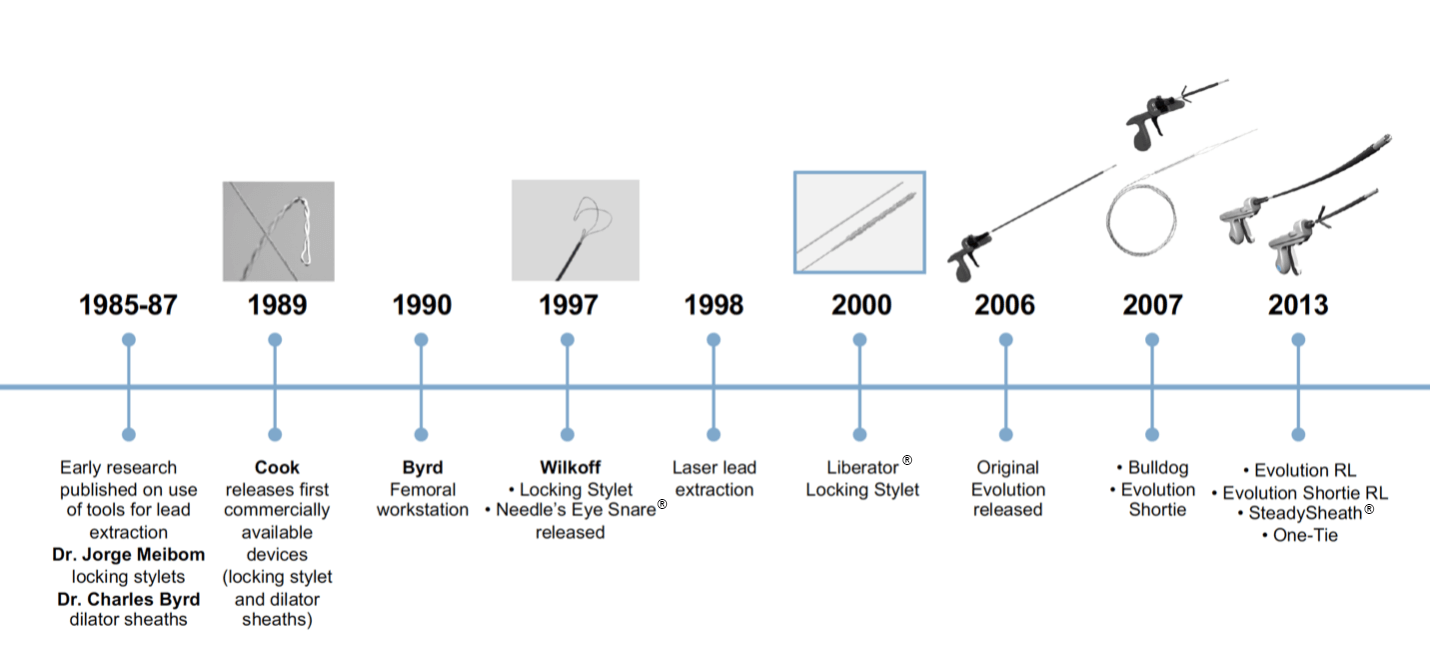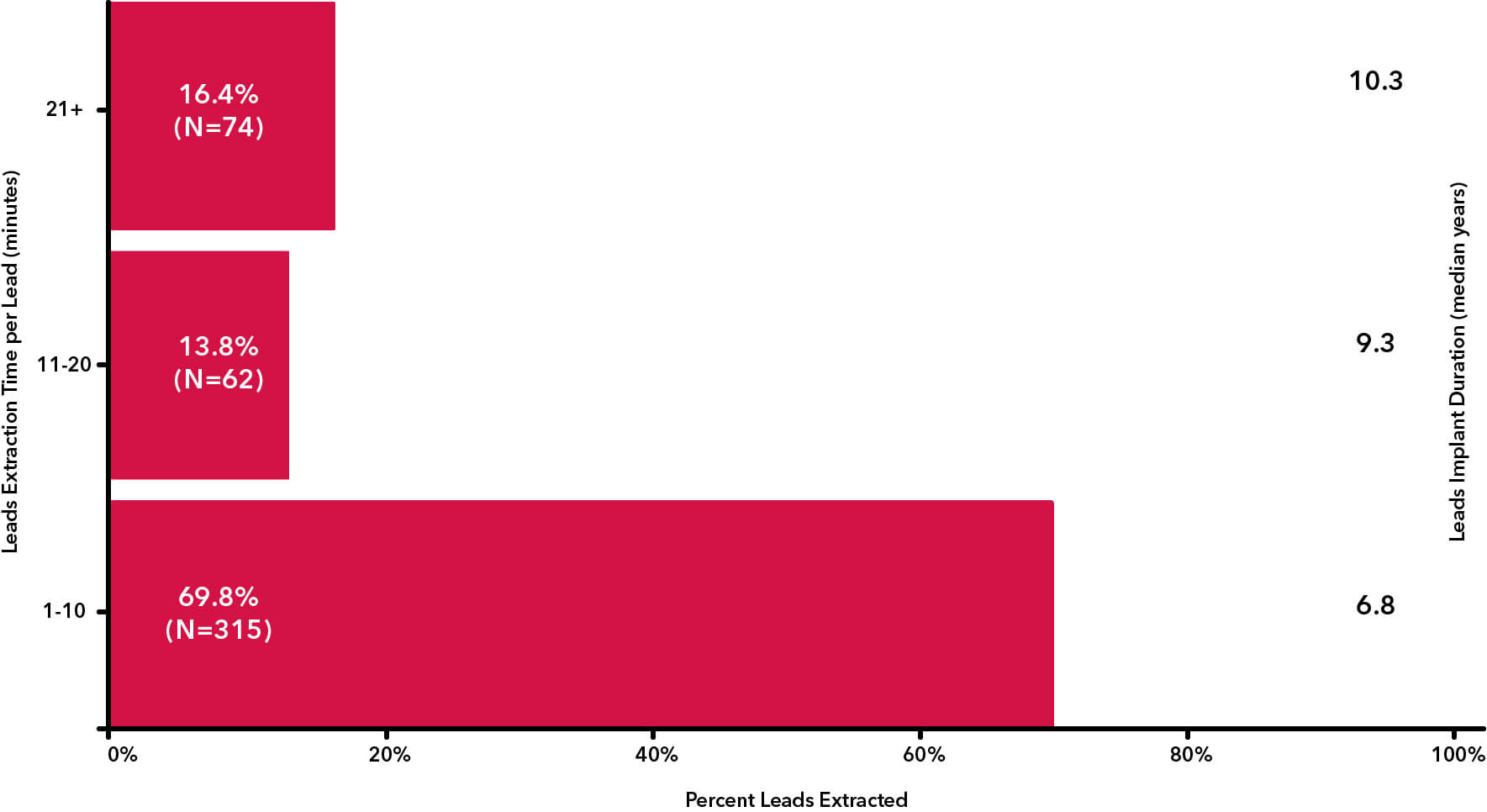Learn about lead extraction
- 1.2-1.4 million cardiac implantable electronic devices (CIEDs) are implanted annually worldwide.1
- Estimated 22,000 lead extraction procedures are performed yearly.2
- 52.8% of procedures are due to infection – the #1 indication.11
- 38.1% of procedures not due to infection are due to lead dysfunction.11
To learn more about lead extraction including indications and treatment options please view our patient resource.
Lead Extraction patient information
Abandonment vs extraction
Lead extraction procedures in patients with previously abandoned leads have shown worsened clinical outcomes, increased procedural time, and increased rates of complication and mortality4 when compared with patients who did not have abandoned leads.
A lead extraction program using Evolution® RL can achieve clinical success rates of greater than 98% with low complications.5,6,7,8 Cook Medical rotational lead extraction can help your patients get back to living.
Cook history in lead extraction
Rotational TLE
What is rotational TLE?
Rotational TLE devices have a proven track record of safety and efficacy.6,7,8,10 The rotational system utilizes a hand-powered flexible sheath with a specialized dissection tip. The inner sheath is activated with a trigger handle, allowing the user to control the amount, speed, and direction of the sheath’s rotation.
Why choose Rotational TLE?
Safety
A 2019 study that reviewed the MAUDE Database for a six-year period stated that lead extraction with rotational sheaths is 7.2 times less likely to result in mortality compared to laser lead extraction.9
“Patient outcomes in the PROMET study compare favourably with other large TLE trials, underlining the capability of rotational TLE tools and techniques to match laser methods in efficacy and surpass them in safety.”10
SVC tears are the leading cause of mortality in lead extraction.14 Using the Evolution RL as a primary approach to lead extraction has shown that it may lower the risk of an SVC injury.8,10 Both the PROMET and RELEASE studies resulted in zero isolated extrapericardial SVC injuries using the Evolution RL.
Efficiency
In the 2021 RELEASE study,8 exclusively using the Evolution RL, extraction times were recorded for 98% of leads (451/460). Those leads had a median implant duration of 7.4 years. The median procedure time was 10 minutes with a median extraction time per lead of 4 minutes.8 The ELECTRa study, which used various device platforms for lead extraction, reported a median extraction time of 19 minutes with a median implant duration of 5 years.11
Control
Rotational lead extraction provides control over the activation of the sheath that is not possible with externally powered devices. The unique trigger mechanism delivers tactile feedback to the physician throughout the procedure.
The amount of sheath rotation is directly proportional to the length of the trigger pull with the Evolution RL, while externally powered devices have a preset energy upon activation. This allows users of rotational devices to have improved feedback and control.
Devices
Evolution RL Controlled-Rotation Dilator Sheath Set
The most recent studies in lead extraction have shown Evolution RL to be safe and effective.5,6,7,8,10
Flexibility
- Allows for the extraction of any lead, including those in difficult vasculature
- Gives physicians the strength and control needed when engaging with dense and calcified adhesions5,6,7,15
Bidirectional extraction
- Actively extract leads when rotating in either direction
- The unique tip allows for disrupting the tissue while rotating in either direction, competitive tools only extract in one direction and unwind in the opposite
- User selects the direction of rotation
Protect companion leads with no lead wrap or damage.5,7,15
Evolution Shortie RL Controlled-Rotation Dilator Sheath Set
Access every lead.
The Evolution Shortie RL is built specifically for vessel entry into the subclavian veins. The Shortie RL combines all the control features of the full-length Evolution with a shorter, stiffer sheath and enhanced tip. These features enable the Evolution Shortie RL to create vessel entry through dense scar tissue and calcification. In some instances, the lead may be removed after achieving vessel entry.
Comprehensive product portfolio
Cook Medical provides the only full product portfolio to support your entire procedure. Lead extraction guidelines3,13 recommend having a full toolbox of devices for any clinical scenario you may encounter. Our comprehensive offering comes without costly capital equipment and service fees. We’re here to help you improve patient outcomes while reducing procedure cost.
Recent studies have shown extremely high success rates when following a step-wise approach to lead extraction,7,10 performing the same steps in a controlled manner for each procedure. Our devices help you navigate each step of the procedure:
Lead preparation
Preparing the lead to be removed may consist of cutting off the connector(s), expanding the inner coil, clearing the inner lumen of the lead, and/or holding the lead without damaging the inner lumen.

